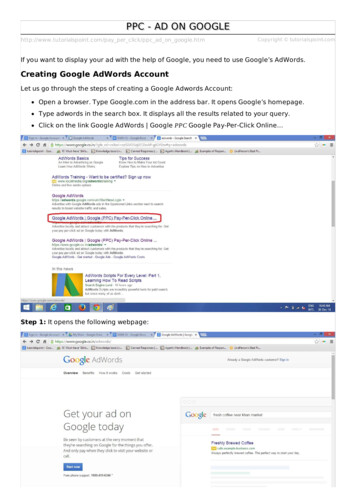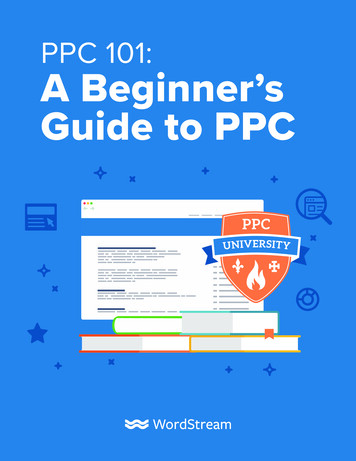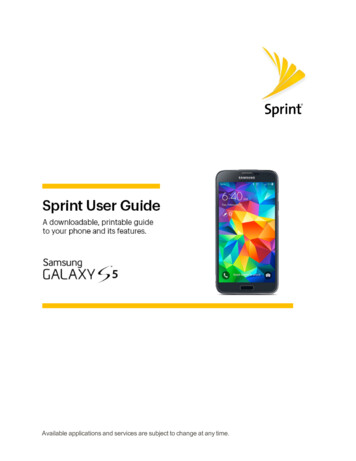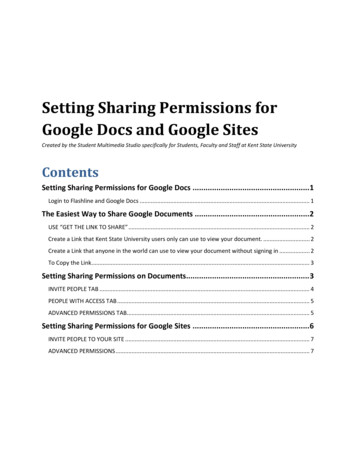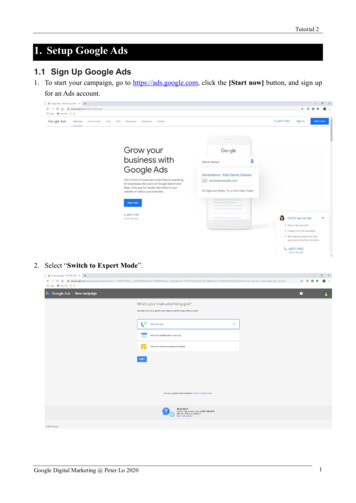
Transcription
Better TogetherCombine AdWords with Google Analytics forBetter Insights, Bidding and Results
IntroductionLike sunshine and the beach, or dogs and tennis balls, Google AdWords and GoogleAnalytics are great by themselves but even better together.You’ll get high-performance insights into your ads and your website when you linkyour AdWords and Analytics accounts. Google Analytics does a vital job in this pairing:it shows you the AdWords traffic that didn’t lead to a conversion. If you assume thatthe average site conversion rate is around 3%, that leaves 97% of traffic that can beunderstood better. A lot better.You can start gathering those detailed insights now by linking your accounts. We’ll beginwith working with Google Analytics metrics in AdWords, then we’ll move on to workingwith AdWords metrics in GA. Across both platforms, remember that these strategiesshould be used in tandem for maximum success.Pull Google Analytics Metrics Into AdWords for Deeper InsightsPage 4Analyze AdWords Performance in Google AnalyticsPage 8Better Together Combine AdWords with Google Analytics2
10 ways to drive results from linked AdWordsand Google Analytics (GA) accountsFirst, pull Google Analytics metrics into AdWords for deeper insights.1.Import goal completions and ecommerce transactions.Why: You can perform richer analysis on customized analytics goals (including microconversions), and then optimize to those GA goals right in AdWords.2.Create custom remarketing lists.Why: Create highly-specific remarketing lists based on pages viewed, goal completionsor other GA segmentations.3.Use Smart Lists to automatically group your site users that are most likely to convert.Why: Reach engaged (but not yet converted) users of your site without needing to segmentthose audiences yourself.4.Understand which Adwords campaigns, ads or keywords drive on-site engagement.Why: Conversions only tell part of the story. GA tells you more about how users engage withyour site, and the keywords that do (or don’t) bring them in.5.Monitor ‘% new sessions’ to learn which keywords attract new users.Why: Spotting new users from AdWords tells you how to focus your efforts, especially whenthey’re coming into contact with you for the first time.Second, analyze your AdWords performance right in Google Analytics.6.Auto-tag your ads.Why: Auto-tagged ads generate more richly-detailed GA reports.7.Segment behavior to understand your AdWords target audience.Why: Discover the right messages and landing pages for each kind of user.8.Layer GA’s secondary dimensions onto your AdWords-specific reports.Why: Secondary dimensions help you see which devices, keywords, placements and moredrive high-quality users.9.Use AdWords Secondary Dimensions in GA Reports.Why: Find AdWords-specific insights using any of your favorite reports in Analytics—insights that can improve your account’s performance.10.Use Benchmarking to see how your site stacks up to the competition.Why: See what’s possible in your industry and how your own desktop and mobile sites compare.Better Together Combine AdWords with Google Analytics3
Pull Google Analytics Metrics into AdWords forDeeper InsightsTIP:You may find minordiscrepancies in data becauseAdWords tracks clicks andAnalytics tracks sessions.(A click is a user’s interactionwith your ad; a session is agroup of interactions that takeplace on your website in onetime frame by one user.)Keep that in mind as youdive into your data.You can get a deeper understanding of the interactions your customers havewith your site by working with Google Analytics metrics within the AdWords interface.That means insight into detailed conversion behaviors, clearer audience profiles, anda better sense of the customer’s journey from their first ad click right through to theconversion you want. Let’s look at some places to start.1. Import Goal Completions and Ecommerce TransactionsA conversion is usually a purchase completed or a lead captured, but a goal can bemany things: a visit to a given page, a certain amount of time spent on a site, or a hostof other things you find valuable.Google Analytics provides you with flexible goal tracking, and those goals can beimported into AdWords as conversions. This helps you perform richer analyses, andalso create goals that double as profiles for specific audiences.Those goals can be certain actions you consider important. For instance: Destination: A visit to a specific page on your site, like a visit to a new /blog page onyour site if you’re trying to build a community with your customers. Duration: The time someone spendson your site. You might use this if youwant users to engage deeply; or, onthe other hand, if you want them tofind information as fast as possible. Pages or screens per session: Howmany pages each user visits—useful ifyou’d rather measure engagement bypage visits instead of by time on site. Event: The moment when someonewatches a video, adds a product to acart, shares a page through a socialbutton, or takes any other action.Helpful if you want users to complete a specific action beyond a destination page view.All these goals can be imported into AdWords as conversions, so you can see andmeasure the actions your ads created.Additionally, you can track the value of your conversions in AdWords.But did you know that you can go even deeper with that tracking in Google Analytics?Ecommerce tracking in GA includes detailed information about products (includingrevenue generated by each), transactions (revenue, tax, shipping and more), and timeto purchase (number of days and sessions it takes to finish a sale). In AdWords,Better Together Combine AdWords with Google Analytics4
TIP:It’s a good idea not to tracksession duration alone. Sessionduration is measured by addingyou’ll be able to see the number of transactions and their associated revenue byimporting your GA ecommerce transactions, and from that you can connect youraccount’s performance directly to your sales data.the time it takes betweenthe different interactionsa user may send to GoogleAnalytics; those interactionscan be pageviews, events orDefine Micro-ConversionsMicro-conversions are small (but valuable!) actions that users take on your site. They mayadd something to their cart, for instance, or download a newsletter.ecommerce transactions. If allinteractions aren’t measuredon the website, or if usersspend long periods of time inone page before leaving yourThese things may not have the value of a 2,000 purchase, but they capture useractions from different parts of the research and buying process—and show you howbest to speak to that audience.site, you may not get the fullscope of that session duration.Once you import these Google Analytics goals into AdWords, you’re free to customizethem further. You can decide how to count them, or what the lookback window should be:You can monitor these different conversions and micro-conversions using the‘Segment’ feature to see reports by conversion name.Better Together Combine AdWords with Google Analytics5
NOTE:Remarketing may necessitatean update to your Analyticstracking code, along with someother requirements.2. Create Custom Remarketing ListsRemarketing lists help you stay in front of users who have expressed interest in whatyou offer. Combine AdWords and Google Analytics and you’ll be able to build smarterremarketing lists to use in your campaigns.3. Use Smart Lists to AutomaticallyGroup Your Site Users that are MostLikely to ConvertSmart Lists are a good option if youdon’t have time to segment youraudience yourself. Google Analyticswill automatically build a list of userson your site who are most likelyto convert, and you can then useremarketing to bring them back toyour site.If you prefer to create your owncustom remarketing lists, try tofind your ideal audience usingGoogle Analytics segmentationcapabilities like pages viewed,location, on-site activity andgoal completions. (Build youraudiences under Remarketingin your Admin tab in GA.) Youcan pick from predefinedlists, or create your own, andinstantly see the estimated sizeof the list that results.Using pre-defined audiencesCreating a custom remarketing listYour goal is to create groupsthat you can reach effectively in the future: groups like homepage visitors, productpage viewers, conversion abandoners or past converters. All of these, and others likethem, are groups you can speak to with specific remarketing messages that will bringthem back to your site.For example: people who first came to your site through a non-paid link on another sitehaven’t clicked your ads, so they may have different expectations when they see yourremarketing ad. Or, if users have watched a video on your site once before, you maysend them to a landing page with a video on it.TIP:Get ideas for your ownremarketing lists by headingover to the Google AnalyticsSolution Gallery. Import aremarketing-related solution oruse one as inspiration for yourYou can use any of Google Analytics’ 250 dimensions and metrics to build thesekinds of highly-specific remarketing lists. The sky’s the limit, and the power is yours:you decide what’s most valuable for your site and your business, and build youraudiences to match.own account.Better Together Combine AdWords with Google Analytics6
4. Understand Which AdWordsCampaigns, Ads or Keywords DriveOn-site EngagementWith your accounts linked, you canadd Google Analytics metrics directlyto your AdWords reports. AddingAnalytics’ site interaction metrics tostandard AdWords metrics like CTRand conversion rate will take thingsto a higher level.Most clicks don’t turn intoconversions. (This is that 97% wespoke of earlier.) Google Analytics metrics can help you see what happened whenthings didn’t turn out quite the way you hoped—and test ways to change that outcome.For instance, you might try out: A new call to action in your ads. How does your message prepare users to interactwith your site? Does their pages viewed or session length change when you changeyour call to action? A new set of keywords. Do your keywords deliver on users’ expectations?Are bounce rates in line with your core keyword base or better? A new campaign landing page. Does a different landing page draw users deeperinto your site? Is their average session getting longer?More data is better when you’re analyzing performance, as long as that data is reallyrelevant. Keep the focus on the metrics that matter most to your account. Then useGoogle Analytics when the primary metrics in your account don’t give you enoughinsight to make effective decisions.5. Monitor ‘% New Sessions’ to Learn Which Keywords Attract New UsersTo see and understand where your campaigns reach customers in their journey,the % new sessions metric can be a big help.TIP:Want to know even more abouthow customers find you? Take alook at Multi-Channel Funnelsand Attribution Modeling inGoogle Analytics. You’ll see howdifferent channels interact withone another as they bring newusers to your site.This metric can be a proxy for new customers to your business. You may have a generalidea of which keywords are driving new customers to your site, but % new sessions willhelp you prove or disprove your hypothesis. Try it when you’re setting goals for youraccount and also when you’re gauging the success of a keyword or a campaign.Certain keywords will bring new users your way. Those users have a different valuethan someone who is returning to re-engage with your site. So plan your messagingand bids appropriately.As you learn more about how familiar each user is with your site or brand, you canimprove the overall strategy for your account.Better Together Combine AdWords with Google Analytics7
Analyze AdWords Performance inGoogle AnalyticsYou can take action by viewing your Google Analytics stats within AdWords, andyou can perform deep analysis by reviewing AdWords performance directly inGoogle Analytics.6. Auto-tag Your AdsBefore we get into the reporting details, let’s start with one piece of technical advice:plan to use auto-tagging on your ads. Save manual tagging for special cases. This willsimplify your life and create more reporting flexibility. There are more benefits toauto-tagging than we can get into here, but you should plan on using it.Analyzing your data directly in Google Analytics will add more dimensions to yourAdWords visits. Something as simple as finding non-converting keywords that stillbring in above-average quality traffic (low bounce rate, high time-on-site, etc.) can leadto big optimizations for your account. The analyses and reports we’ll look at here arejust scratching the surface of what’s possible. We hope they’ll inspire your own uniquecustom insights as you work with your linked accounts.7. Segment Behavior to Understand Your AdWords Target AudienceGoogle Analytics has a powerful segmentation engine. Instead of looking at youraudience in large bunches, you can break it down into its component parts andunderstand how each part interacts with your site—then bid, message and directtraffic accordingly. (You can even build them for yourself with the Segment builder.)TIP:Create your own customsegments for even deeperanalysis. Or, import additionalsegments (here are some forPaid Search) to your accountfrom the Google AnalyticsSolutions Gallery.Better Together Combine AdWords with Google Analytics8
Here’s an example: How dousers coming from AdWordsreact to your site on theirfirst visit? To find out, run aDestination URL report inGoogle Analytics, then segmentit by New and Returning Users.In this case you may also learnwhich pages on your site coulddouble as good landing pagesfor AdWords traffic.You can also learn helpfulAdWords lessons from therest of your traffic. Check outsome suggested segments andanalyses on page 11 that youcould run in your account.TIP:Try creating your owncustom dimensions if youhave information about yourlogged-in users from outside ofGoogle Analytics, such as fromyour internal systems. You’llsee how distinct sets of thoseexisting customers perform.8. Layer GA’s SecondaryDimensions onto YourAdWords-specific ReportsWant to know where yourmost profitable customerscome from? Try layering GA’sflexible secondary dimensionsonto your AdWords-specificGA reports.Secondary dimensions in GAwork like AdWords segments,except that there are more ofthem and they’re more flexible.Better Together Combine AdWords with Google Analytics9
First, pick a question—any question. Then investigate the right dimensions to find theanswer. For instance:Question: Do users behave differently on my site if they came there by clicking an adfrom the top of a page?To find the answer: Add an Ad Slot dimension on your campaign/ad group reports.TIP:GA reports can also help youdetermine the right AdWordsbid adjustments for location,device and time of day. GAwill show you details aboutacquisition, behavior andconversions to layer on towhat you’ll see in AdWords.Question: Should I add more exact match keywords to my campaigns?To find the answer: Try Query Match Type layered onto your campaign reports.Question: Are there certain keywords that perform better on mobile?To find the answer: Try Device Category layered onto your keyword reports.9. Use AdWords Secondary Dimensions in GA ReportsNow let’s put your AdWords account performance into perspective by layeringAdWords secondary dimensions on a Google Analytics report.No matter which report you run in Analytics, you can add AdWords dimensions ontothat report for a deeper level of understanding of your AdWords traffic. These reportswill not only be insightful— they’ll help show you what to do directly in AdWords.Determining bid adjustments through a Geographic report is just one example.Think about the reports that you value most in GA and then see what that reportcan teach you about your AdWords account.What you learn from those secondary dimensions will show how you how to messageto AdWords users and where to send them to on your site.NOTE:This report may requireyou to update your Analyticstracking code.TIP:Enhanced Ecommerce canhelp you dig even deeper intoyour on-site transactions.You’ll learn more about whatusers view and add to theircarts, and what happens whenthey abandon a purchase.Here’s one example: Run a report for Audience Demographics Age. Then add theAd Slot secondary dimension onto your report. Now look to see: Are more younger thanolder people clicking your AdWords ads on the top? Is there a clear reason why?How can you use that reason to improve your AdWords bidding and messaging?10. Use Benchmarking to See HowYour Site Stacks up to the Competition“How’m I doing?” Benchmarking reportsshow how your site stacks up againstaggregated industry data from othercompanies who anonymously sharetheir data. Benchmarks put yourperformance into context. They helpyou set meaningful targets, learnabout trends in your industry, and seehow you compare to the competition.Define your performance against the competitionFor example, try benchmarking yourChannels to see if you’re driving less paid search traffic than your peers. There may beinterested users out there that others are drawing in, but that you haven’t discovered yet.Better Together Combine AdWords with Google Analytics10
Recapping the IdeasWe’ve mentioned many different analyses to run in this paper. Here’s a complete listof the ideas we’ve discussed. It’s just a start: use these as inspiration as you think aboutlooking for insights in your own account.NOTE:The links in the second columnwill lead you to the relevantGoogle Analytics report, soAnalysis to RunInsight fromGoogle AnalyticsLinks are case sensitiveDimension orSegment AddedAre any of my non-convertingkeywords still driving highquality traffic?Acquisition AdWords Keywordshttp://goo.gl/4KxIlRSearch for ‘Goal ConversionRate’ equals zeroDo users who click ads on theright-hand side of a page behavedifferently from those who clickat the top of search results?Acquisition AdWords Campaignshttp://goo.gl/OBHrVXAd Slot dimensionShould I add more exact-matchkeywords to my campaigns tobetter manage that traffic?Acquisition AdWords Campaignshttp://goo.gl/OBHrVXQuery Match Type dimensionAre there certain keywordsthat perform really well formobile users?Acquisition AdWords Keywordshttp://goo.gl/4KxIlRDevice category dimensionIs there behavior beyondon-site conversions that I shouldfactor in as I set my AdWordsbid adjustments?Acquisition AdWords Bid Adjustmentshttp://goo.gl/4AVDfaChoose between Device/Location/ Ad ScheduleHow do first-time users fromAdWords react to my site?Acquisition AdWords Destination URLshttp://goo.gl/r1lt1FNew and Returning UserssegmentsWhich pages deliver strongPage Values or low bouncerates for my organic traffic?Could they be used as landingages for AdWords traffic?Behavior Site Content Landing Pageshttp://goo.gl/szQs77Organic or Referral Trafficsegment. (You could also createa custom segment with acollection of non-paid channels)Are my users from AdWordsfundamentally different fromthe rest of my traffic? Shouldthat change my messaging?Audience Demographics Agehttp://goo.gl/vljc5wAd Slot secondary dimensionHow does my site handle mobileusers compared to my peers?Audience Benchmarking Deviceshttp://goo.gl/x3XMQQHow do my mobile users fromAdWords compare to the rest ofmy mobile users?Audience Mobile Overviewhttp://goo.gl/jZyEGTmake sure you are signed inwhen you click them.NOTE:Reports in blue here can alsobe run within AdWordsBetter Together Combine AdWords with Google AnalyticsDefault ChannelGrouping dimension11
ConclusionWe mentioned dogs and tennis balls at the start of this guide. But let’s be clear:linking AdWords with Google Analytics is about a lot more than chasing data back andforth. It’s about finding insights that will give you an edge in the marketplace.Those insights come from people who don’t convert on your site as much as fromthose who do. That’s where Google Analytics really shines. It helps you see how yourAdWords account does and doesn’t reach the customers you want most. That will helpyou change your bids, ad copy, even the time and place you run your ads to reach thepeople who will convert for you.AdWords and Google Analytics really are better together. Best of all, it’s easy to link them.You can do it right now, right here.To view other Google Best Practices, check out the full collection at g.co/GoogleBP.Better Together Combine AdWords with Google Analytics12
Better Together Combine AdWords with Google Analytics 3 First, pull Google Analytics metrics into AdWords for deeper insights. 1. Import goal completions and ecommerce transactions. Why: You can perform richer analysis on customized analytics goals (including micro-conversions), and then optimize to those GA goals right in AdWords. 2. Create .


